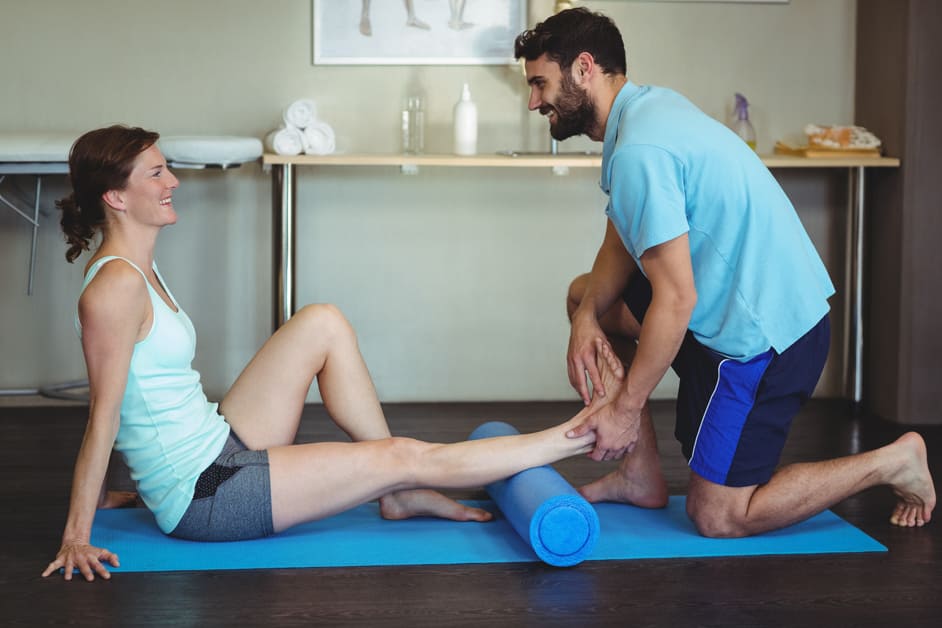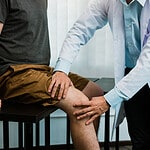Introduction
Foam rolling is a great way to treat knee osteoarthritis. It’s a type of self massage. Studies show it can help reduce pain and improve mobility. It also helps reduce stiffness and increase range of motion.
Let’s look at what the research says about foam rolling for knee osteoarthritis. We’ll also explore the implications and considerations:
What is Osteoarthritis?
Osteoarthritis is a common form of arthritis. It usually affects adults who are 50 or older. It damages the cartilage between two bones, like knee or hip joints. This causes stiffness, fluid, and inflammation. The pain and swelling can be mild or severe.
As the condition progresses, physical activity can become hard. Diet and exercise can help manage symptoms. Foam rolling for knee OA could be useful. It involves rolling a foam cylinder around the knee joint. This reduces tension in tight muscles, increases circulation, and promotes mobility. This can improve function and reduce pain.
What is Foam Rolling?
Foam rolling, also called myofascial release, is a safe and great exercise for those with knee osteoarthritis. It’s a self-massage way to let go of muscle tightness and boost mobility. It can help lessen muscle stress, pain, and increase the range of motion of the joints. This can give significant advantages to people with knee osteoarthritis.
This technique uses a foam roller that you place on the floor for support and stability. As you roll up and down the roller, you target certain muscles. When done accurately, you’ll feel a deep tissue stretch that helps reduce rigidity, improve blood flow, and relax tension in tight muscles close to the knee joint. This can help relax the muscles near your bones to reduce stiffness or ache as well as improve flexibility and power.
Foam rolling can be used on several areas of your lower body, but careful attention should be given when targeting particular muscles around the knee so that proper care is taken when applying pressure during your roll-out routine:
Benefits of Foam Rolling for Knee Osteoarthritis
Foam rolling is a hit with athletes and those with joint pain. But, it can be very helpful for those with knee osteoarthritis! It assists in reducing pain, plus improving range of motion, flexibility, and strength. Moreover, foam rolling improves overall quality of life.
Let’s learn about the benefits it can bring to knee osteoarthritis sufferers!
Improved Mobility and Flexibility
Foam rolling is a type of self-myofascial release (SMR) and is getting more popular in exercise science and physical therapy. It involves using a cylindrical tube of foam, aka the foam roller, to apply pressure on tight muscles, myofascial trigger points and other soft tissue dysfunctions. Doing it properly and consistently can help with knee osteoarthritis, improving mobility, flexibility and relieving pain.
Foam rolling increases blood flow to the area and reduces inflammation. It relaxes tight muscles around the joint and breaks any adhesions. This relieves tension and pain, while strengthening the muscles to better support the knee.
Foam rolling may also improve range of motion (ROM). It’s used before activity to increase circulation, which loosens up tight muscles for more movement. This not only enhances performance but also reduces risk of injury and stiffness from OA.
Reduced Pain and Swelling
Foam rolling has been linked to lots of benefits, like improved joint range of motion, reduced muscle tightness and pain relief. Studies suggest it can reduce joint-related inflammation for those with knee arthritis. It may also improve gait speed and stability, reducing the risk of falls or other injuries.
Furthermore, one study found that patients’ self-rating pain levels decreased significantly after 3 weeks of twice daily foam rolling sessions. This suggests that foam rolling can be an effective treatment to reduce perceived pain levels alongside other physical therapy interventions.
Increased Circulation
Foam rolling is an impactful way to reduce Osteoarthritis (OA) of the knee. Applying pressure and massage-like movements boosts circulation in your musculoskeletal system. Greater circulation lessens inflammation, improves flexibility, and provides pain relief. Enhanced circulation also helps to lessen joint stiffness caused by arthritis, as well as increase nutrient intake to affected tissue for faster healing.
If you have knee OA, foam rolling regularly will be helpful in many ways.
How to Foam Roll for Knee Osteoarthritis
Foam rolling is an excellent choice for physical therapy for knee osteoarthritis. It’s safe and has many benefits. It can lessen pain, boost mobility and restore the function of the joint.
To foam roll correctly and safely for knee osteoarthritis, follow these steps:
Preparing to Foam Roll
Foam rolling can help ease tension in painful regions and make knee osteoarthritis more bearable. Preparing for foam rolling is key for success. Here are some tips:
- Find a space to move without hitting anything. Wear something comfy to move in and make sure the foam roller takes your weight.
- Contract and then loosen the muscles around your knee joint while keeping the joint in its neutral position.
- Put pressure on areas needing attention, like where you feel pain, tenderness, or tightness. You may need more than one session. Move slowly and work on areas until they dissolve naturally, and stretch tight muscle fibers to restore flexibility.
- After foam rolling, lightly massage any sore spots with a lacrosse ball or massager. Then, stretch again to cool down.
Foam Rolling Techniques
Foam rolling can help reduce knee OA pain from muscle tension. Roll away from the knee and focus on nearby muscles, like quads, adductors, hamstrings, glutes, IT band, and calves. Pressure on tight muscles can release tissue and increase blood flow, reducing pain. Start slowly with gentle pressure and increase as you become comfortable. Here are some tips:
- Start with a mild intensity before gradually intensifying.
- Keep breathing normally.
- Try short pulses of pressure, followed by release.
- Roll in multiple angles for deeper tissue mobilization.
- Go slower than you think is necessary.
- Roll perpendicular on IT band, not longitudinal.
- Move slowly over body parts without bouncing.
- Avoid full weight on tender areas.
- Reassess areas of tension after each session.
Post-Foam Rolling Care
Foam rolling done? Time to cooldown and stretch! Reduce inflammation, increase range of motion. Start with five to ten minutes of light activity suitable for your fitness level – maybe a light jog or walk. Breathe slow and regular. Become aware of your body messages. Then move onto the stretching protocol.
Do dynamic (active) stretches for the leg muscles – hip flexors, quadriceps, hamstrings – aiming for 15-20 seconds each. This will reduce built up tension in the muscles, especially around the knee joint. Also do static (passive) stretches lasting 30 seconds. Take breaks between sets, adjust intensity levels as needed – based on how your body feels during the session. Monitor areas like tenderness levels at impacted joints. Adjust intensity levels in subsequent sessions, if needed.
Conclusion
Foam rolling is a great way to reduce pain and help with knee osteoarthritis. It’s simple to do and has no negative side effects. Plus, it may provide temporary relief! Studies have shown that foam rolling can be beneficial. Therefore, it’s worth a try for those with knee osteoarthritis!
Summary of Benefits
Foam rolling is a safe and effective way to help people with knee osteoarthritis. It can reduce pain and improve joint mobility. It should be used as an adjunct to traditional treatments, such as stretching programs and lifestyle changes.
Plus, foam rolling can improve hip abduction strength. This can give extra protection when walking or running. It also increases blood flow, hydrates tissues and reduces edema through better lymphatic drainage.
Foam rolling is not only an intervention, it is also a form of self-management. People can do it at home. This is great for those who can’t travel or alternate between therapists or clinics due to cost or wait times.
So, if you are looking for a comprehensive way to care for knee osteoarthritis beyond drugs or surgery, foam rolling is an attractive option.
Tips for Safety and Effectiveness
Foam rolling can help relieve knee osteoarthritis pain. But, there are important things to keep in mind:
- Warm up before rolling. This helps the circulation and keeps muscles safe.
- Go slowly. Rolling slowly allows deeper penetration into the tissue.
- Control pressure. Start with light pressure and build up.
- Limit session time. 15 minutes is best.
- Do it regularly. Twice a week is ideal.
- Also roll on non-training days. This helps recovery and improves performance.
Frequently Asked Questions
Q1: What is foam rolling?
A1: Foam rolling is a type of self-myofascial release that uses a foam roller to apply pressure to the muscles and tissues. This type of massage helps to release tightness and tension in the body, promoting improved mobility and flexibility.
Q2: Is foam rolling safe for people with knee osteoarthritis?
A2: Yes, foam rolling can be a safe and effective option for people with knee osteoarthritis. When done properly, it can help to reduce pain, improve joint range of motion, and increase circulation in the area.
Q3: How often should I foam roll for knee osteoarthritis?
A3: It is recommended to foam roll for knee osteoarthritis at least two to three times a week. It is important to start slowly and not overdo it. If you experience any pain or discomfort, stop and consult with your doctor.





